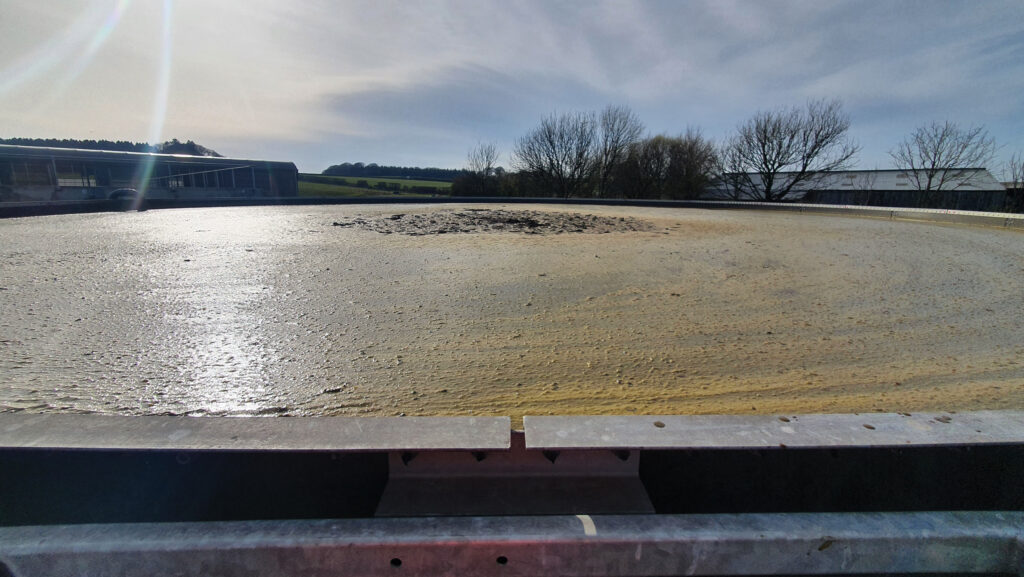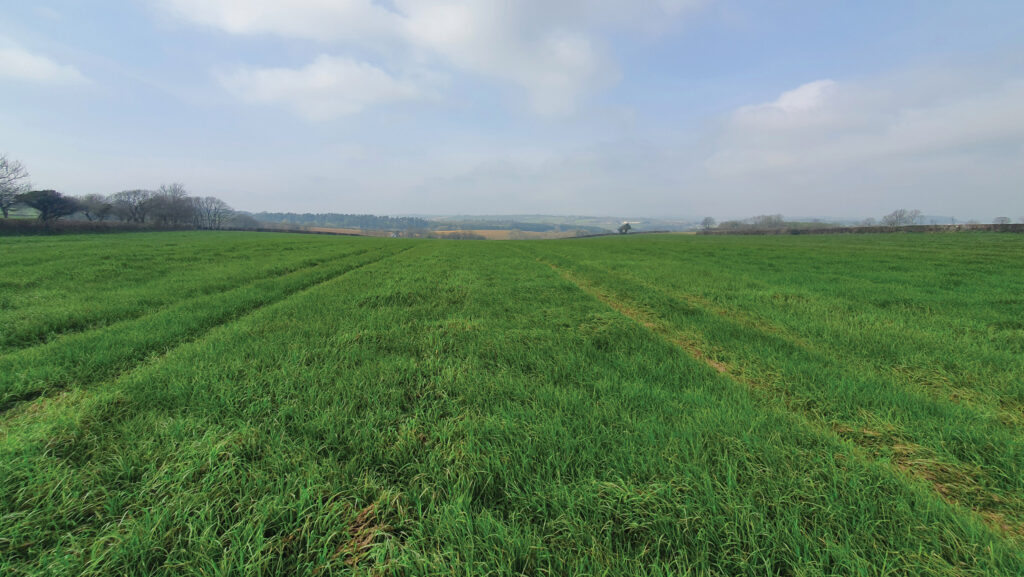How a slurry inoculant helped increase grass yields by 20%
 © Sylgen Animal Health
© Sylgen Animal Health Use of a slurry inoculant on a Cornish farm resulted in fewer nutrient losses and a boost in grass yields by nearly 20%, a trial has shown.
These resulted in a return of £4.99 for every £1 invested, rising to more than £20 – and yields up to 30% higher – when the trial was repeated for a second year.
Silage inoculants are typically cocktails of various bacteria that are claimed to improve the management of slurry by retaining key nutrients and reducing losses.
This benefits the soil and offers farmers an opportunity to reduce their reliance on artificial fertilisers.
See also: How slurry inoculants helped halve farmer fertiliser use
In a bid to prove the efficacy of such products, Duchy College carried out in-depth research on SlurryForSoil from Sylgen Animal Health.
This inoculant is based on a combination of 18 species of rhizobacteria and fungi, as well as four enzymes.
Presenting the research findings at the recent Dairy Day event, Richard Brealey from Sylgen explained that the inoculant turns slurry into a bioactive fertiliser.
The microbes are claimed to enhance nitrification and ammonia conservation, as well as mobilise nutrients and micronutrients. It also offers biocontrol of plant pathogens, diseases, nematodes, molluscs and insect pests.
Trial design
The 2022 trial involved 134 cows from the Duchy’s Future Farm herd, split into two groups, each with dedicated slurry lagoons.
Everything else about the management – housing, bedding and diet – was kept the same.
The control lagoon was left untreated, while the trial was treated with the inoculant at a rate of 1kg for every 120,000 litres of expected final slurry volume.
Samples were collected from the lagoons after the first and second doses of the inoculant (applied 12 weeks apart) and sent to the lab for analysis.
Following this, the slurries were applied to a fourth-year ryegrass/clover ley on clay soil, and the resulting silage was analysed for its nutritional quality.
The results

© Sylgen Animal Health
The researchers found that there was better retention of key nutrients, as well as micronutrients including copper, zinc, magnesium and calcium, in the slurry.
Compared with the untreated slurry, the treated version contained:
- 51% more ammonium nitrogen
- 4% more phosphorus
- 6% more potassium
- 89% more sulphur.
Advantages of the inoculant were also seen in the forage analysis.
Headline findings, based on the average across three cuts, included a 17.8% yield increase – with some cuts achieving a 30% yield boost – as well as a 5.78% increase in crude protein levels. (See table below).
The trial concluded that these improvements amounted to a minimum return of £4.99 (the value of the increased grass yield and any fertiliser savings) for every £1 invested in the inoculant.
However, a calculation error resulted in an overestimate of the cost of the inoculant.
In addition, a management slip meant yields from the treated and untreated areas for one of the silage cuts that year had to be regarded as equal.
The trial was repeated in 2023, and the inoculant delivered similar results, increasing dry matter (DM) yields by 30% across three cuts (compared with untreated slurry), leading to a £23.20 return for every £1 invested.
“Different years with different weather patterns will always give different results,” Richard told Farmers Weekly.
“SlurryForSoil might seem to result in larger benefits when climatic conditions are worse.”
Mean difference between silages fertilised with treated and untreated slurries across three silage cuts2022 Duchy College trials |
|
|
Mean difference in forage analysis results (based on dry weights) between silages fertilised with treated and untreated slurries (+/- %) |
|
|
Dry matter (g/kg) |
+8.86 |
|
Crude protein (g/kg) |
+5.78 |
|
D-Value |
+9.14 |
|
Metabolisable energy (MJ/kg) |
+8.96 |
|
Neutral detergent fibre (g/kg) |
-7.09 |
|
Ash (g/kg) |
-0.79 |
|
Oil-A (g/kg) |
+29.64 |
|
Sugar (g/kg) |
+46.27 |
|
Nitrate nitrogen % |
+39.23 |
|
Buffering capacity meq/kg |
+9.04 |
|
Fresh weight yield (t/ha) |
+11.46 |
|
Dry matter yield (t/ha) |
+17.8 |
|
Source: Sylgen Animal Health |
|
What to watch for when using slurry inoculants
While treating slurry with an inoculant can provide a range of benefits, there are also pitfalls to be aware of.
This is according to Janice Radford, farm business consultant at Douglas Green Consulting.
She said farmers should exercise caution when it comes to investing in inoculant treatments.
With dairy margins tight, Janice said one of the biggest factors to consider is what independent research is available to prove the value of the inoculant, and that there will be a cost benefit to using it.
“Some of the inoculants cost about 50p/t to treat.
However, because dirty water is now classed as slurry and has to go into the slurry store [in England], this significantly increases the volume of slurry that farmers are having to handle and treat.
“So, your 50p/t-product becomes £1/t because you’re effectively having to treat rainwater too.
“I advise calculating the area of dirty yards on your farm and how much extra cost this will incur.”
Janice added that another area of concern is parlour washings, which now have to go into slurry stores as well.
The challenge with this, she believes, is that parlour washings contain high levels of disinfectants, which kill bugs.
“Disinfectants will not discriminate between mastitis bugs and the bugs in the slurry inoculants.
“Before spending money on products, I’d want to see research that demonstrates this isn’t an issue.”
Testing
For products shown to be cost-effective, backed by independent research and not affected by dirty water and parlour washings entering the slurry store, however, Janice said: “I would definitely recommend inoculants if they can show that they capture nutrients, make them more available to the crop, and give farmers a cost-effective response.”
“If you do use a slurry inoculant, make sure that you test your slurry before spreading and adjust your nutrient plan accordingly, otherwise you will not make the savings on your fertiliser bill that you need to make.
“Margins are tight in milk production, so farmers need to be careful to evaluate all products that they invest in and make sure they will add to their bottom-line profit.”
In response, Richard Brealey from Sylgen Animal Health said: “The amount of SlurryForSoil required is dependent on the volume of slurry produced by the cows, so the cost does not increase with any rainwater.
“In some cases, the inclusion of rainwater can improve the efficiency and effectiveness of microbes, as the increased liquidity of the slurry improves the microbes’ ability to colonise the store.
“While an extremely high concentration of disinfectant might affect the microbes, in reality the amount entering a slurry store is insignificant – they are rapidly inactivated by the organic matter.
“The majority of our on-farm trials [following the Duchy research] had parlour washings in the treated slurry stores and the results showed that this had no effect.”
